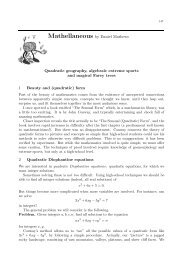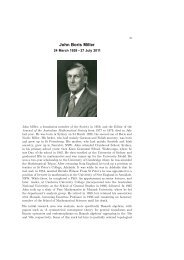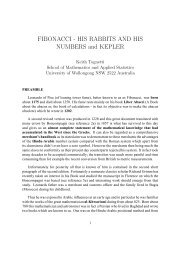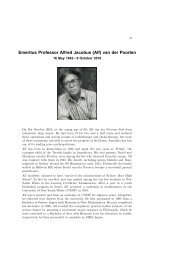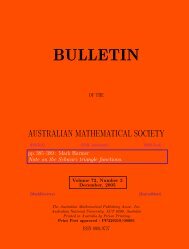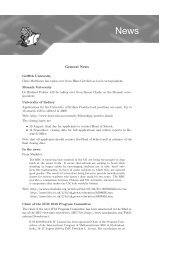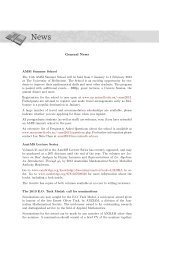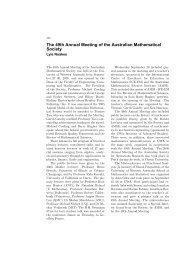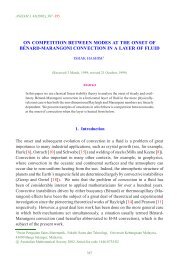Gazette 31 Vol 3 - Australian Mathematical Society
Gazette 31 Vol 3 - Australian Mathematical Society
Gazette 31 Vol 3 - Australian Mathematical Society
You also want an ePaper? Increase the reach of your titles
YUMPU automatically turns print PDFs into web optimized ePapers that Google loves.
208 Book Reviews<br />
In this sense, the JSJ decomposition of a<br />
3-manifold can be seen as a regular neighbourhood<br />
of all its immersed tori.<br />
The three properties above can be formulated<br />
in terms of enclosing of almost invariant<br />
subsets into vertices of Γ. The authors<br />
prove in a very general setting, that a<br />
splitting Γ satisfying these properties (with<br />
some additional technical assumptions) is<br />
unique. This is what the author call the<br />
regular neighbourhood of a family of almost<br />
invariant subsets. The uniqueness claimed<br />
here is a strong uniqueness, in particular,<br />
not up to certain moves.<br />
The main theorem claims that for a<br />
finitely presented group G which does not<br />
split over a virtually polycyclic group of<br />
Hirsch length < n, there exists a (unique)<br />
regular neighbourhood Γ of all the H-almost<br />
invariant subsets of G where H varies<br />
among virtually polycyclic groups of Hirsch<br />
length n. Moreover, there is a description<br />
of this splitting. For simplicity, we only give<br />
a rough description for a one-ended torsion<br />
free group G where one only consider almost<br />
invariant subsets over Z. For each vertex<br />
v ∈ Γ of the first kind, one of the following<br />
holds:<br />
• Γv is cyclic<br />
• Γv is the fundamental group of a surface<br />
with boundary Σ such that the incident<br />
edge groups correspond to the fundamental<br />
groups of the components of ∂Σ.<br />
• Γv is the full commensurizer of a cyclic<br />
group H such that G/H has more than<br />
one end.<br />
Some vertex groups of commensurizer type<br />
might fail to be finitely generated, and edge<br />
groups may fail to be finitely generated (and<br />
thus may fail to be cyclic).<br />
The authors also extend their results to<br />
include almost invariant subsets over virtually<br />
abelian groups of bounded rank (several<br />
ranks may occur) and almost invariant subsets<br />
over virtually polycyclic groups of two<br />
successive Hirsch lengths.<br />
The splitting obtained is unique (in a<br />
strong sense), and therefore invariant under<br />
automorphisms. This is one of the<br />
main features of the construction. This<br />
makes it adapted for the study of automorphisms<br />
of G. In this sense, this splitting<br />
may be seen as a generalization of<br />
Bowditch’s JSJ splitting for one-ended hyperbolic<br />
group [Bowditch, Cut points and<br />
canonical splittings of hyperbolic groups,<br />
Acta Math. 1998]. Compared to other<br />
JSJ theories by Sela, Rips-Sela, Dunwoody-<br />
Sageev and Fujiwara-Papasoglu, the main<br />
difference is that here, the central notion<br />
is enclosure (or compatibility of splittings).<br />
Instead, the central notion in the JSJ theories<br />
cited above is the fact that a splitting<br />
is elliptic with respect to another, which<br />
means that edge groups of one splitting are<br />
contained in vertex groups of the other splitting<br />
(up to conjugacy). Ellipticity of a splitting<br />
with respect to another one is a much<br />
less rigid requirement than compatibility.<br />
This strengthened rigidity is the main reason<br />
of the strong uniqueness of the obtained<br />
splitting and of its invariance under automorphisms;<br />
there is no such strong uniqueness<br />
for the JSJ splittings obtained by the<br />
authors above. A paper in preparation by<br />
Levitt and the reviewer will give a unified<br />
setting for those JSJ theories.<br />
This long paper explains in detail the<br />
motivations and the topological analogies<br />
with immersions. It develops many technical<br />
tools devoted to the study of almost invariant<br />
subsets. The authors first construct<br />
the regular neighbourhood of a finite collection<br />
of almost invariant subsets, and prove<br />
the uniqueness in general. Under a small<br />
commensurizer hypothesis, some finiteness<br />
properties are proved allowing to deduce the<br />
existence of the regular neighbourhood of all<br />
the Z-invariant subsets. The generalization<br />
of this finiteness property without this hypothesis<br />
is more tricky. Then the authors<br />
extend the results to include almost invariant<br />
subsets over virtually polycyclic groups.<br />
The paper includes, as an appendix, two





